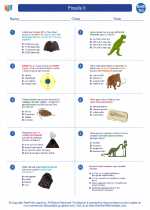Periodic Table
The periodic table is a tabular arrangement of the chemical elements, organized by their atomic number, electron configurations, and recurring chemical properties. It is a fundamental tool in the study of chemistry and is used to predict the behavior of elements and their chemical compounds.
Organization of the Periodic Table
The periodic table is organized into periods (rows) and groups (columns). The elements are arranged in order of increasing atomic number, and elements with similar chemical properties are placed in the same group.
Key Features of the Periodic Table
Periods: There are seven periods in the periodic table, each corresponding to a new energy level in the electron shells of the elements.
Groups: The elements in the periodic table are divided into 18 groups based on their chemical properties. These groups have specific names and characteristics.
Metals, Nonmetals, and Metalloids: The periodic table is divided into metals, nonmetals, and metalloids. Metals are located on the left side of the periodic table, nonmetals on the right, and metalloids along the staircase line.
Valence Electrons: The group number of an element corresponds to the number of valence electrons it has. Valence electrons are the outermost electrons in an atom and are involved in chemical bonding.
Study Guide for the Periodic Table
- Memorize the names and symbols of the first 20 elements in the periodic table.
- Understand the organization of periods and groups in the periodic table.
- Learn the properties of metals, nonmetals, and metalloids and their locations on the periodic table.
- Practice writing electron configurations for different elements.
- Understand the concept of valence electrons and their role in chemical bonding.
- Explore the trends and patterns in the periodic table, such as atomic radius, ionization energy, and electronegativity.
By mastering the periodic table, you will have a strong foundation for understanding the behavior and properties of elements in the study of chemistry.



